Support strong Canadian climate journalism for 2025
British Columbia's forest has drawn a short climate straw. The polar amplification of global warming is altering the climate much faster here than in more southern forests. These rapid climate shifts are unleashing more wildfires, droughts and insects.
The province's magnificent forest is one of the most carbon-rich ecosystems on the planet. The towering old-growth trees, in particular, are champions of carbon storage. Decades ago, B.C.'s forest absorbed huge amounts of CO2 from the atmosphere. Its carbon sink provided an immensely valuable service to Canadians and its logging industry.
Sadly, that's now gone. Instead, the forest has transitioned over the last two decades into emitting CO2. Lots of it. And the wood harvested from it has been piling millions of tonnes more of CO2 on top of that. What started out as a worrying CO2 trickle has turned into a flood.
That's the grim story told by the government's forest carbon data in B.C.'s official emissions inventory report. To illustrate the startling scale and speed of what's unfolding, I created the chart below from that data. Here's the tale it tells.
Forest carbon collapse
Forests pull CO2 out of the air to create new growth. And forests emit CO2 back into the air when trees and plants die and rot. The balance of new growth versus new decay determines the net amount of CO2 a forest removes from the air.
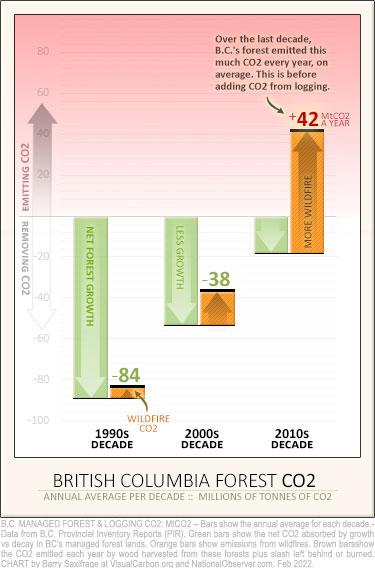
On my chart, the downward green bars show the annual averages for how much CO2 was removed in each decade. As you can see, net growth in B.C.'s forest has steadily collapsed to a fraction of what it was.
At the same time, wildfire has exploded. The orange bars show the average CO2 emissions from forest fires. This tripled during the 2000s and then tripled again in 2010s.
This one-two punch of declining net growth and surging wildfire has flipped the forest from a huge carbon sink into a huge carbon source.
The bars on the left side of the chart show that back in the 1990s, the forest removed an average of 84 million tonnes of CO2 (MtCO2) per year. The middle bars show that this shrunk to an average of just 38 MtCO2 per year in the next decade. Then in the 2010s, the trends continued past the tipping point. B.C.'s forest flipped to emitting an average of 42 MtCO2 per year.
On top of that is the additional CO2 emitted by logging.
Harvesting wood like it's still 1990
Harvested wood, and the slash left behind, emit CO2 when they get burned or eventually rot. The government tracks and reports the amount each year. Its data shows these logging emissions have stayed fairly steady over the last three decades, averaging around 46 MtCO2 per year. That's a lot of CO2, roughly equal to the emissions from all fossil fuels burned in the province.
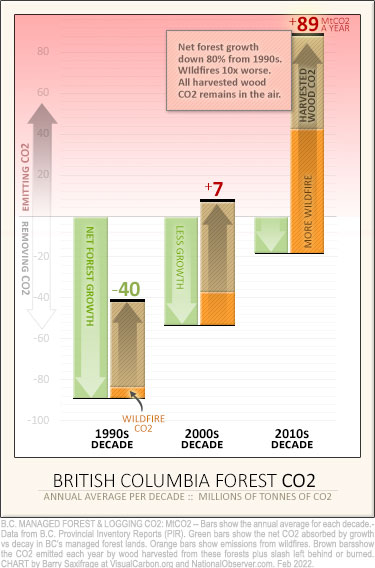
I've added brown bars to the chart to show these logging emissions.
Back in the 1990s, the forest removed more CO2 than harvested wood emitted. So, the logging industry called their wood products "carbon-neutral."
But during the 2000s, logging levels and emissions stayed high even as the forest failed to keep up. As a result, around seven MtCO2 per year, on average, was added to the atmosphere.
Then in the 2010s, as discussed above, the forest was unable to offset any CO2 from any source. It was emitting CO2 even before accounting for logging. Despite this, the industry and the B.C. government continued logging at old-climate, 1990s levels. The bars on the right side of the chart show the result. Harvested wood CO2 accumulated in the atmosphere — on top of what the forest was emitting. The CO2 trickle that started in the 2000s turned to a flood, averaging 89 MtCO2 per year.
In fact, the data shows that in every individual year since 2002, harvested wood emitted more CO2 than the forest removed from the air. Every year, more wood was being logged than the forest was growing back. When something happens every year for 20 straight years, it isn't an anomaly — it's the new reality. Does this sound like sustainable logging to you?
And does logging a forest that is hemorrhaging CO2 sound "carbon-neutral"? Not to me. It sounds like yet another form of climate delay and denial.
What now?
The just-released sixth assessment report by the Intergovernmental Panel on Climate Change says: "Increased heat waves, droughts and floods are already exceeding plants’ and animals’ tolerance thresholds, driving mass mortalities in species such as trees and corals."
It goes on to say that these threats are expected to continue: "Continued climate change substantially increases risk of carbon stored in the biosphere being released into the atmosphere due to increases in processes such as wildfires, tree mortality, insect pest."
In one example specific to B.C., the IPCC report said wildfires in 2017 burned "seven to 11 times the area that would have burned without climate change."
National Resources Canada also expects climate impacts to worsen in Canada's forests. Its State of Canada's Forests 2020 report opens with this warning: "Scientists predict that increasing temperatures and changes in weather patterns associated with climate change will drastically affect Canada’s forests in the near future. With the rate of projected climate change expected to be 10 to 100 times faster than the ability of forests adapt naturally."
The climate science and the government's data make it painfully clear that our forests are already struggling under an increasingly destabilized climate. And so are we. If we want any shot at avoiding a full-blown climate crisis, we need to stop pouring fuel on the crisis with our CO2.
That includes dealing with all the new CO2 we've started pumping into the atmosphere by logging our forests faster than they are growing back.
*****
Endnotes:
- Since 2002, the wood logged in B.C. has emitted a total of 660 MtCO2. The forest has emitted another 325 MtCO2. Combined, they've pumped nearly a billion tonnes of CO2 into the atmosphere.
- Nearly half of the wood harvested in Canada comes out of B.C.'s forest.
- Overall, Canada's managed forest lands have lost three billion cubic metres of wood volume since 1990. That's a loss of more than two billion tonnes of CO2 storage.
- The primary use of harvested wood in Canada is burning it as fuel. Burning wood is more CO2-intensive than burning coal per unit of energy. For wood to be a competitive fuel, its CO2 must be removed from the atmosphere somehow.
- Removing a tonne of CO2 from the air with machines and sequestering it underground currently costs around $1,200. The lost carbon sink in B.C.'s forest was a valuable service that will be hard and expensive to replace.
- Further reading: For those looking for more details on forest carbon in Canada, here's my in-depth explainer on forest carbon trends and the government efforts to shift responsibility for the rising flood of CO2.

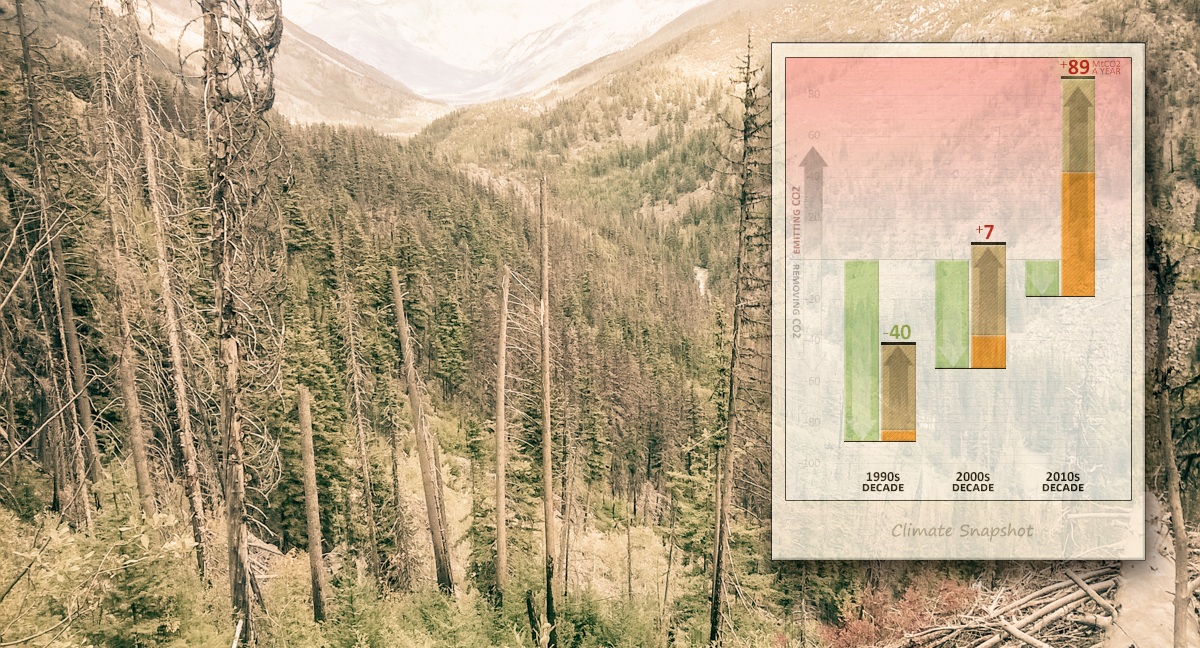

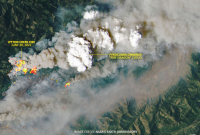
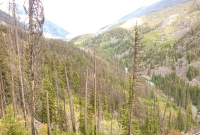

Comments
Thank you for this informative article. The graphs really demonstrate how things have changed in BC (where I live) regarding forests, logging and wildfires. It's pretty shocking.
However I don't understand this quote: "The primary use of harvested wood in Canada is burning it as fuel." In my area of Interior BC, the primary use of harvested wood is making 2x4's. Please explain....
Climate change has created another unfortunate positive feedback loop with respect to forests: The more the climate warms, the more forest fires, which in turn lead to more warming. It's pretty depressing. And we need more wood to build back towns such as Lytton- or will we start using a different building material?
Thanks for your comment, Patricia. As part of the National Inventory Report, the government tracks how the wood harvested in Canada gets used. It reports the end-of-use emissions from the wood in an obscure spreadsheet known as CRF table 4.Gs1. For 2019, it shows the mix at 43% burning wood for energy; 27% paper products; 29% various solid wood products. Back in 2005 the percentage from burning was the same (43%) but paper products were higher (35%) and solid wood products were lower (23%). So there seems to be a slow shift from paper to solid products happening.
Wood pellets for UK and Japanese power stations are the new go to for the forest industry in Canada and the US
Trees are no longer referred to as lumber but as "wood fibre"
In some cases they are even harvesting old growth for pellets.
In the meantime we are sending masses of logs somewhere to make into 2 X 4’s or?? I live where we take a ferry past Crofton, every time I go by the pulp mill I am horrified at the huge piles of raw logs being loaded onto ships to go offshore. The mills of the island have closed and the jobs left are only loggers & logging trucks….soon there won’t be a forest…..JOBS then??? We are NOT looking at the future!! Modern clear cutting is a crime! I’ve lost hope. Cheerio from Salt Spring
In the meantime we are sending masses of logs somewhere to make into 2 X 4’s or?? I live where we take a ferry past Crofton, every time I go by the pulp mill I am horrified at the huge piles of raw logs being loaded onto ships to go offshore. The mills of the island have closed and the jobs left are only loggers & logging trucks….soon there won’t be a forest…..JOBS then??? We are NOT looking at the future!! Modern clear cutting is a crime! I’ve lost hope. Cheerio from Salt Spring
What a huge story that's not being reported. Mr Saxifrage should get a prize for bringing this info to the public. Bad news. But needed.
Barry now provides data that clarifies how harvested wood releases more CO2 than other forms, like dimension lumber that is protected from decay while embedded inside structures. Clearly, manufacturing wood pellets must be banned along with raw log exports.
BC's forests have been harvested at roughly the same volumetric rate for decades, but the number of jobs in the industry has decreased by about half. This makes everything industry says about forestry (lots, especially access to old growth) and genuine forest ecology (very little) entirely suspect.
The BC government was historically purchased by forest industry interests and swayed by industry rhetoric about jobs and revenue without regard to the major party in power. Today, the NDP is stuck in a contradiction sandwich trying to "protect jobs" while also paying lip service to "protecting the environment" -- in addition to consulting with Indigenous communities on forestry and other issues.
Some non-urban First Nations are caught up in the debate. The Pacheedaht Nation, for example, seems to be split over old growth logging at Fairy Creek, now a famous site for protest. The Indigenous pro-logging faction states who, if anyone, has managed the forest for millennia, and by extension has the right to continue making decisions either for extraction or preservation?
That's a good question, and it is part of the ongoing treaty negotiations. However, their historic environmental management applies to a 10,000 year-old continuously stable climate, not to today's onslaught of climate destabilization, record forest fires and climate-related ecological disruption to our temperate forests.
The simplistic act of banning is an incomplete solution. Instead, forest ecology principles must today be applied to all imperilled forests everywhere. And those principles must today account for the possible effects of global heating on forests.
What Barry misses in the body of his otherwise great writings is the complete carbon cycle. The trees contained in a forest are only half the story. The missing half is all about soils. Half the biomass and carbon in a forest is contained in the soils it grows in, and about half of the released carbon emanates from the exposed, disturbed soils of clearcuts.
Moreover, a forest is not a collection of individual trees, but a contiguous, conjoined collection of life forms working together as a whole when you look both above AND below the ground. Mycorrhizae fungi encompass the root systems of hundreds of trees and can transfer nutrients and moisture hundreds of metres.
This implies that the best forestry practices today in a "managed" forest will, as in a naturally evolved climax forest, consist of a continuous, unbroken canopy and soils that are not disturbed by harvesting even a fraction as much as traditional logging methods. It means that stream banks and riparian edges will be subject to meaningfully expanded setback requirements. It means that all old growth areas and sensitive ecologies will be protected forever. And it means that a shift in silviculture will occur to bring practices closer to a genuine understanding of forest ecology -- with an emphasis on adaptation research.
Our cedar species biome could evolve under climate warming conditions to move further north and be replaced by firs and pines. In a managed forest that would be pines bred with less susceptibility to the pine beetle and greater fire resistance and recovery capability, and left to mature in a continuous cover to shade the soils. International co-operation will become more common. The US Pacific Northwest and BC could become sanctuaries for the climate-impacted coastal California redwood (Sequoiadendron sempervirons). The beetle-free mountain redwood (Sequoiadendron giganteum) seems to survive drought and fire better than pines and could become a replacement species in some cases.
Best forest practices would also apply to a better management regime. Perhaps it's time to look at local community ownership, like a forest trust managed by towns, regional districts and First Nations based entirely on continuous cover and ecological principles, particularly the carbon cycle. Though towns today must consider establishing and maintaining fire breaks at their edges due to the increasing risk of fire, the forest lands beyond would be subject to forest trust jurisdictional rules where planted and preserved trees exceed harvesting by orders of magnitude, and where harvesting practices have nothing to do with clearcutting practices or allowing cut blocks in excess of a tiny area. The forest trust model would appear more in keeping with a series of municipal departments rather than a gigantic provincial bureaucracy.
The move towards mass timber construction is an excellent idea. The act of banning things like raw log exports should be counter balanced with creating new jobs in sustainable wood-based industries. The zero emission Passive House is a design in keeping with BC's Step Code and entails both sustainable forest practices and a dramatic reduction in energy consumption, often at zero emission rates. They are also far healthier buildings. Today there are several plants manufacturing Passive House wall, floor and roof units under strictly-controlled factory conditions and with precision tolerances, and in many cases with outstanding design, construction schedule and cost control.
Suzzane Simard is a UBC forest ecologist who recently published a book called 'Finding the Mother Tree' which promotes an ecological view in forest management and preservation. She was consulted on the latest provincial forestry policy outlook, and is a regular critic of the 19th Century practices that still prevail today.
https://suzannesimard.com
It is possible to have Fairy Creek provincial parks, vast Great Bear Rainforest national parks, well-managed plantations where carbon emissions are far less than carbon capture and storage under regenerative forest practices with flexibility to account for climate variables, and a wood construction and high value manufactured product export industry that together are entirely sustainable.
This is not meant to be a doomer message.